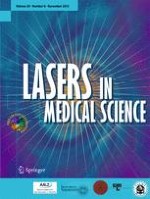01-11-2015 | Original Article
Ultraviolet radiation after exposure to a low-fluence IPL home-use device: a randomized clinical trial
Published in: Lasers in Medical Science | Issue 8/2015
Login to get accessAbstract
The prevailing advice is to avoid sun exposure after intense pulsed light (IPL) hair removal. However, no systematic evaluation of ultraviolet radiation (UVR) after IPL hair removal exits. Therefore, we investigated the occurrence of side effects in subjects receiving solar-simulated UVR after a low-fluence IPL treatment with a home-use device. Sixteen subjects with Fitzpatrick skin types (FST) II-V were enrolled. Three constitutive buttock blocks (4.4 × 6.4 cm) were each subdivided into four sites, randomized to one IPL exposure of 0, 7, 8, or 10 J/cm2 (spectral output 530–1100 nm). Blocks were randomized to no UVR or three standard erythema doses (SEDs) UVR either 30 min or 24 h after IPL. Follow-up visits were 48 h, 1 week, and 4 weeks after IPL. Outcome measures were (i) clinical skin reactions, (ii) reflectance measurements of erythema and pigmentation, and (iii) pain. Subjects with FST II–IV experienced no skin reactions up to 4 weeks after IPL, neither erythema, edema, blisters, crusting, textual, nor pigment changes. Reflectance confirmed no change in erythema and pigmentation (p ≥ 0.090). UVR exposure induced erythema and increased pigmentation. The combination of IPL and UVR induced skin reactions not different to responses from UVR (IPL-UVR vs. UVR, p ≥ 0.164). Pain was generally low (median 1, range 0–4) and correlated positively with fluence and pigmentation (Spearman’s rho ≥ 0.394, p < 0.001). One subject with FST V experienced perifollicular hyperpigmentation after IPL and slightly more intense when exposed to UVR. A single UVR exposure of three SEDs either shortly or 1 day after low-fluence IPL causes no amplification of skin responses in constitutive skin of individuals with FST II–IV.





